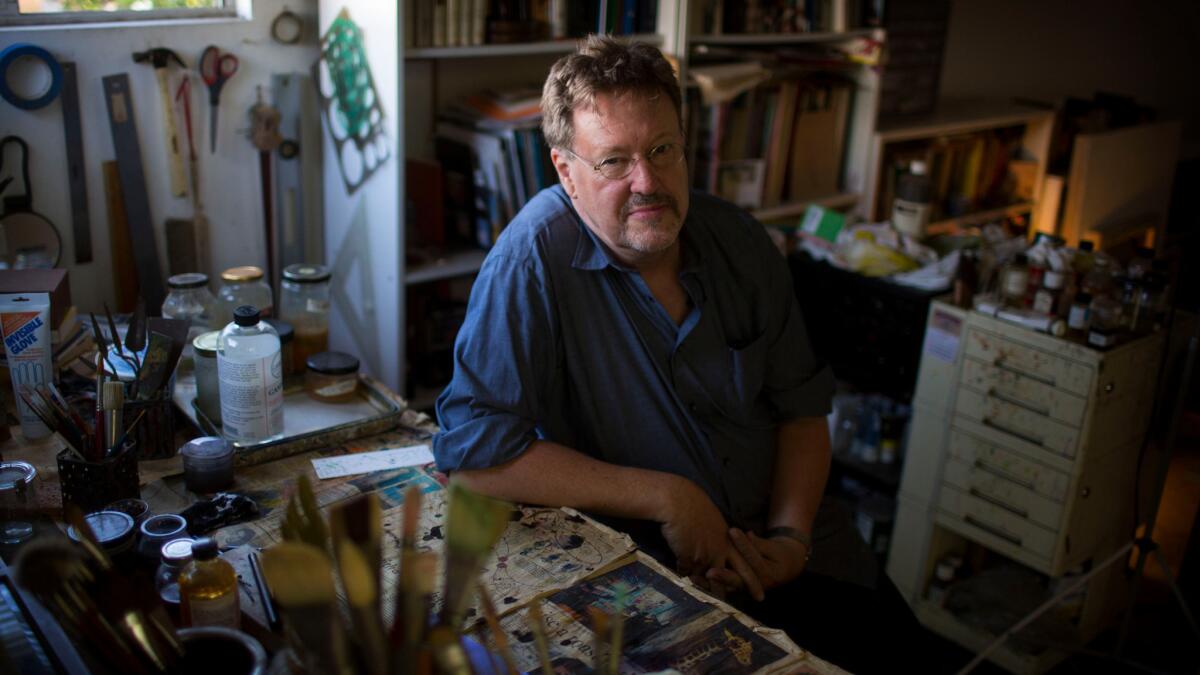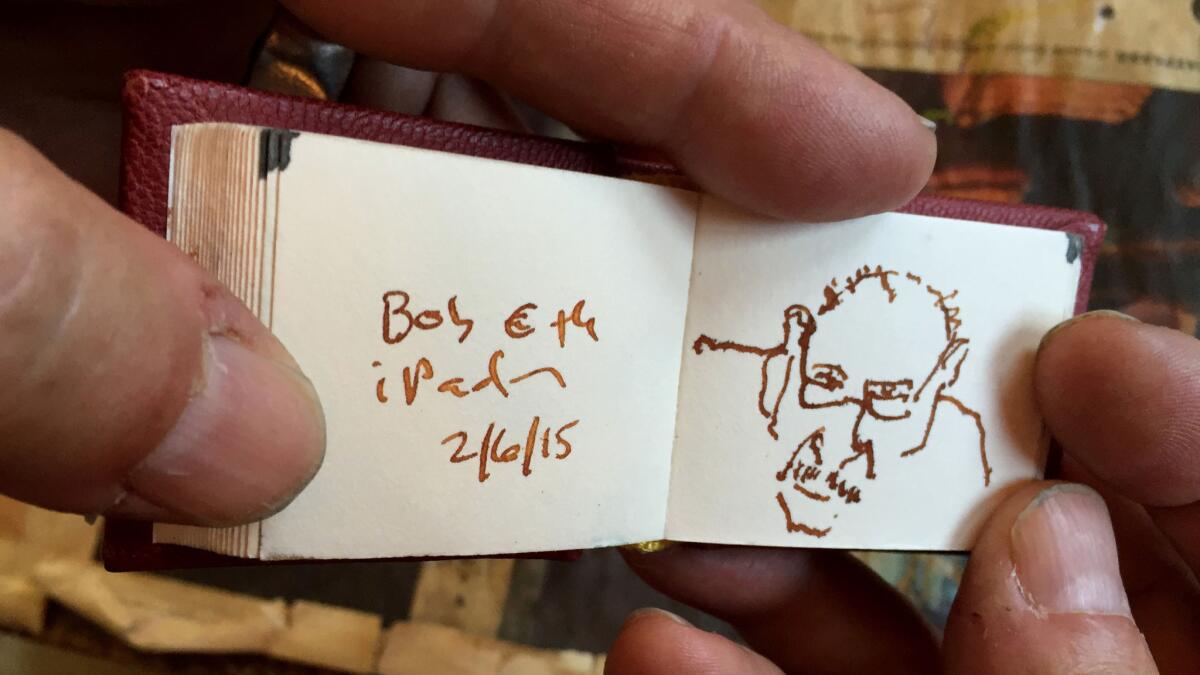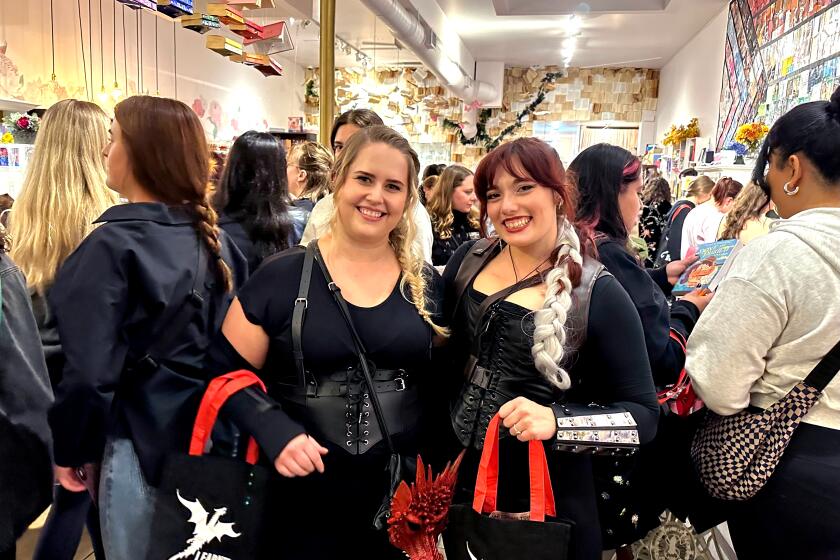‘The Vermeer of Los Angeles’? Slow-art champion Tom Knechtel lets us in the studio

- Share via
In an art world that spins ever faster, Tom Knechtel is slow.
“He’s so slow,” says CB1 Gallery’s Christopher Ford, “I call him the Vermeer of Los Angeles.”
Ford, who organized the artist’s first Southern California solo show in the late 1980s at Santa Monica’s now-defunct Pence Gallery, says Knechtel’s work is worth the wait.
His achingly crafted funny-visceral drawings and paintings take the anxieties of modern life and render them in ways that are surreal yet historical.
In a Knechtel painting, a vortex of expressive yellow swirls might inhale a Renaissance dome along with a wrestler riding a pink high heel. A dog’s thought bubble might be filled with another dog — and another thought bubble. Men grope and make out and sport members that look happy to see you. Details are rendered with methodical madness and very skinny paintbrushes.
If the all-too-precise German Renaissance master Albrecht Dürer and the hallucinatory Hieronymus Bosch had had an affair and moved to California, Knechtel would have been their love child.
What also makes a Knechtel exhibition special is that one doesn’t happen very often. His last solo show was in 2011. It featured exactly three paintings and 11 drawings. The one before that was in 2007. Over his 3-1/2-decade career (he is 64), he’s had one solo museum survey: “On Wanting to Grow Horns,” held at the Ben Maltz Gallery at Otis College of Art and Design in 2002 (which traveled to museums in North Carolina, Honolulu and Seattle).
All of this makes his concurrent shows at Marc Selwyn Fine Art in Beverly Hills and CB1 Gallery in downtown Los Angeles feel a little like the transit of Venus.
“I’ve never made assumptions that my career should work in any other way,” says the artist of his famously slow output, adding, with one of his trademark, sonorous laughs, that he is an honorary member of “SPIT” — a group of L.A. artists who have dubbed themselves the “Slowest Painters in Town.” (The club also includes artists Judie Bamber, Monica Majoli and Sharon Ellis.)
Knechtel has the aspect of an amiable professor (he teaches at ArtCenter College of Design in Pasadena). And art, to him, represents a deep, scholarly commitment to hard work in the studio. The rat race of art fairs just isn’t his shtick.
“It is if that’s what you allow the art world to do to you,” he says nonchalantly, seated amid the orderly clutter and colorful paint splatters of his home studio. “You don’t have to. You just make peace with yourself — with where you are at in the work, with where you are at in your career.”
Knechtel began to explore the fantastical qualities of human and animal figures at a time when painting was making a hard turn toward the minimal. And while his subjects often include modern subjects — contemporary evocations of gender identity and gay desire — he does so employing techniques inspired by a profound interest in Renaissance painting, Indian miniatures and out-there mysticism (he is a great admirer of William Blake).
In his 1997 canvas, “A Middle-Aged-Scheherezade,” a pensive male figure stands deity-like before a flat mustard background donning what appears to be a broad, fluttering skirt.
But when examined closely, the skirt turns out to be made of dozens other images: a movie poster, a circus tent, loose horses and dogs. In one hand, the man holds a locket showing two nude men clutching each other in fervid embrace.
On the one hand, “Middle-Aged Scheherezade” is wholly modern. Yet it is evocative of those wild northern Renaissance scenes in which everything in the village square appears to be happening at once.
“You can’t fit him into a movement or pigeonhole him with an easy label,” says Marc Selwyn, the gallerist who has represented him for more than 15 years. “That’s always a challenge for the art world to understand, to embrace an artist in the same way that they do when they are part of some easily recognizable movement.”
For Knechtel, it’s less about adhering to some artistic orthodoxy than it is about generating a space for the imagination.
“I want to slow the viewer down,” he says, “so that they wouldn’t get it just by looking at it, but by diving in.”
The worlds he creates aren’t just on canvas. Step into the artist’s Mar Vista home, which he shares with his husband, Bob Baruch, and you will find yourself surrounded by Yantra meditation paintings and vintage Mexican retablos — not to mention countless works by artist friends: Charles Garabedian, Paul Brach, Mira Schor.
Knechtel’s studio, located in a small garden apartment in the back, also feels rather magical, with a miniature book collection and containers stuffed full of fountain pens (which he employs in his art).
On the walls are drawings in progress. One is a tender view of Knechtel’s sleeping husband. Another is a self-portrait of the artist crying inky tears. The latter was inspired by a visit to the Indian art collection at the L.A. County Museum of Art — specifically, an 18th century drawing from Rajasthan.
“It’s the tears of a man surrounding this poetry,” he says. “His nose is nothing. It’s this vacant shape. It’s his tears that fill the page.”
Over the last several years, Knechtel’s work has grown increasingly personal. Some of it has to do with wanting to challenge himself, some of it with the happenings of his own life. In this period, he has lost both of his parents in quick succession and Baruch was diagnosed with Parkinson’s disease.
“I wanted to step away from the allegory, to move away from the world of animals and wrestlers and theater,” he explains. “I wanted something that threw the windows open. What does Bob look like when he’s sleeping? What do my parents look like when they watch TV?”
The exhibitions at Marc Selwyn and CB1 are, to a large degree, composed of these new, more intimate works. In many, an exaggerated version of the artist’s face stares out from the page — fine-lined renderings that show him looking tired and jowly, his visage atomizing into a dazzling array of inky particles. It’s the look of a man with mortality on his mind.
“I’d never done portraiture or self-portraiture before,” says Knechtel as he gestures toward his tearing face. “I wanted to use myself as a material — a convenient model who wouldn’t mind how it looked.”
Rest assured that the Knechtel on the wall bears little resemblance to the bright, funny person seated before me — one whose evocative belly laugh the writer Benjamin Weissman once compared to “a Broadway show tune.”
Within minutes, he is guffawing over some of his early attempts at art-making: “I was doing these little theaters where you looked through a hole and you’d see rubber babies glued all over the proscenium. It was awful!”
Despite being a master draftsman — “he has an incredible facility,” says Selwyn, “he draws like an angel” — Knechtel came to art as an adult, something to do when his Plan A, toy-making, didn’t work out.

Knechtel was born in Palo Alto and raised in Sunnyvale and Mountain View. His father was as an aeronautics engineer and his mother studied anthropology. As a child, he remarks, he was not particularly into visual art, but his parents instilled a healthy appreciation for culture: “My father took me to see [Jean] Cocteau and my mother introduced me to Blake.”
In high school, he devoted his spare time to making stuffed animals: small, fantastical confections crafted from felt that depicted charming creatures such as a polka-dotted hedgehog and a mouse wearing a fringed cape. (He retains a few in his home to this day.)
During his senior year of high school he decided he would not take the SAT because Blake would never have done such a thing. Instead, he announced to his father that he would be a toymaker.
“My father, to his credit, never said a word,” he recalls. “Of course, it was a total failure. I opened in June and was bankrupt by August. And that fall I enrolled in community college.”
Queue the Knechtel belly laugh.
He ended up at CalArts in 1972, at a time when art was turning toward performance, the minimal and the conceptual. “If you showed anything representational, it was derided as ‘picture-making,’” he says. “I really struggled with this.”
He found his milieu among feminist artists, specifically, in a class taught by Schor (now based in New York), which examined representational work — from dollhouses to ancient Indian painting. The feminist artists were interested in issues of gender, identity and the body, all questions that intrigued Knechtel.
“It gave you incredible permission,” he says. “All of these young gay men really benefited from the efflorescence of feminism, but we didn’t have to do the heavy lifting of consciousness raising.”
Schor, who has remained a friend, and who has a sprawling solo show on view at CB1 concurrent with Knechtel’s, says it was an interesting phenomenon.
“I think the feminist artists were more sympathetic to the gay artists,” she says. “The focus on the body and the scale. We were looking at non-Western narrative, at figurative art. All that went against the male minimalist ethics of the time.”
By the time he graduated, Knechtel had begun to create early versions of the dream-like theatrical scenes for which he would later become known. By the late 1970s, he’d landed his first solo exhibition, at Rubicon Gallery in the Bay Area. A decade later, he was firmly ensconced in L.A. and had begun to establish the every-few-years exhibition schedule that allows him to focus on painting above all.
Los Angeles, he says, is the kind of place that provides plenty of space to an artist who doesn’t go with the flow.
“L.A. has a kind of permission,” he says. “The museums aren’t always paying attention, which is good. You can have a wide community of friendships that aren’t compromised by ambition.”
After completing the work for his two current exhibitions (Selwyn is showing paintings and drawings, while CB1 is focused on new and historic drawings and prints), Knechtel swore he would “take two months and sit on the couch and read.”
That plan hasn’t really worked out. The painting from Rajasthan that he spied at LACMA got him right back in front of the easel.
What would he be doing if he hadn’t stumbled into painting?
That’s easy, says Knechtel: “I’d be an elementary school teacher with an extensive collection of Disney-ana.”
And then he laughs.
+++
“Tom Knechtel: Astrolabe” at Marc Selwyn Fine Art and “Tom Knechtel: The Reader of His Own Self” at CB1 Gallery
When: “Astrolabe” at Selwyn opens Saturday and runs through Oct. 29; “Reader” at CB1 runs through Oct. 30.
Where: Marc Selwyn Fine Art, 9953 S. Santa Monica Blvd., Beverly Hills, and CB1 Gallery 1923 S. Santa Fe Ave., downtown Los Angeles
Info: marcselwynfineart.com and cb1gallery.com
Sign up for our weekly Essential Arts & Culture newsletter »
»
»
»
Find me on Twitter @cmonstah.
ALSO
The anti-mega gallery: The impromptu shows at Henry Taylor’s living room exhibition space
More to Read
The biggest entertainment stories
Get our big stories about Hollywood, film, television, music, arts, culture and more right in your inbox as soon as they publish.
You may occasionally receive promotional content from the Los Angeles Times.











